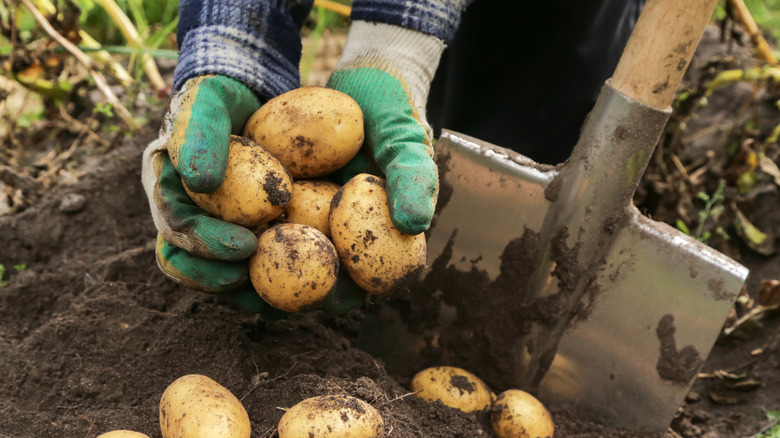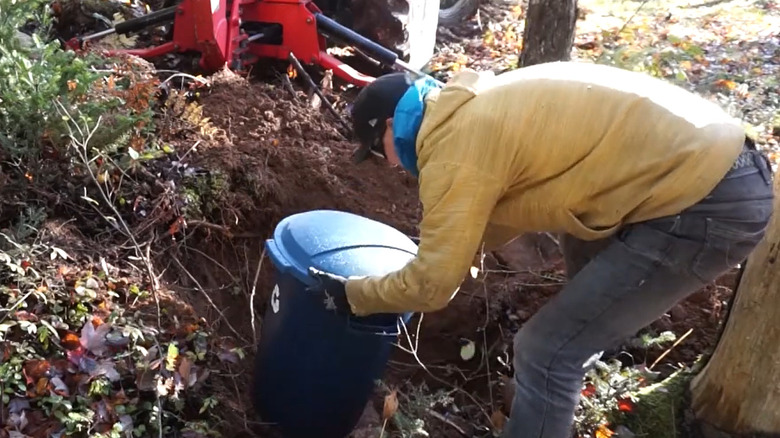Help Potatoes And Onions Last Longer With A DIY Root Cellar Storage Solution
At the end of a growing season, unearthing plump potatoes and onions from your garden is like opening a gift. You don't know what you're going to end up with, but if you're lucky, you'll dig up a bountiful harvest for bushels full of long-lasting produce. However, to make sure they do indeed last a long time, you need to store both potatoes and onions in a way that keeps them safe from moisture, light, and animals. If you're blessed with a bit of land, carve out a simple root cellar made of a lidded trash can. Apartment or condo dwellers, there are great methods for storing these root vegetables indoors over long periods of time, as well.
For outdoor storage, make sure you have a spot at a high point in your yard so that water won't collect around your buried container. Gather a 10-gallon plastic trash can with a lid, some pine wood shavings and straw, and a shovel. You'll also need a couple sheets of foam insulation boards and a wooden board that will lay over the top of the opening and the foam boards.
If an outdoor cache is out of the question, you'll need a container with built-in ventilation like a plastic or natural fiber basket, and some clean cloth or paper. If shelf or floor space is limited, go vertical by hanging your harvest in a mesh bag. No matter which trick you try, don't store both potatoes and onions in the same container; onions give off a gas that causes potatoes to sprout.
Old-school earthen storage
Potatoes and onions stay well-preserved in dark, dry spots at 45 to 50 degrees Fahrenheit. The ground outside our back door provides us with exactly those conditions. The YouTubers from Eager Gridless Beaver carved out the ideal storage nook for their potato harvest that's performed beautifully over several seasons.
Scout out the best spot on your land for your subterranean stash; our YouTubers chose a sloped spot so that any water would flow past the can rather than collect around it. Dig down to a point where about 90 percent of the can sinks into the hole. Carefully backfill the hole so that the added soil doesn't crush the can. Place the lid on the can; if it's curved, set it on the can upside down so the insulation boards will rest on a flat surface. Set the insulation on top. Pack the soil around any exposed bits of the trash can. Also mound up enough soil around the insulation boards so that the top board is flush with the soil.
Make sure you've cured your vegetables for storage before stocking them in your root cellar. Cover the base of the can with wood shavings. Add a layer of potatoes and a bit more shavings; you'll want to maintain a 50-50 mix of shavings and vegetables. Stir the vegetables into the shavings enough that they avoid touching each other, then continue layering until the container is full up to a few inches from the lip or until you've stored all your vegetables. Finally, set the lid in place, cover it with straw, the two layers of foam board, and the wooden board. They should keep well for months.
No yard? No problem
It's not impossible to replicate the conditions created by an outdoor root cellar indoors. As long as potatoes or onions stay in cool, dark, and dry spots, they should stay edible for months. Seek out the coolest, darkest corner of your home; a closet in your basement or in a room far from your thermostat is a good option. If you've got a mesh laundry bag or two that don't get lots of use, enlist them to keep your potatoes and onions fresh and out of sight. Hang them in a cool, dark, spot that's free of moisture.
If you've got a real bounty to save, grab a basket or a milk crate with perforated sides, place a layer of veg on the bottom of the container, cover it with a clean cloth or paper, and repeat. Make sure the top layer is covered, as well. Like for the other storage tips, place the container in a cool, dark, and dry spot.

